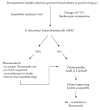Invasive fungal infections in the ICU: how to approach, how to treat
- PMID: 24445340
- PMCID: PMC6271196
- DOI: 10.3390/molecules19011085
Invasive fungal infections in the ICU: how to approach, how to treat
Abstract
Invasive fungal infections are a growing problem in critically ill patients and are associated with increased morbidity and mortality. Most of them are due to Candida species, especially Candida albicans. Invasive candidiasis includes candidaemia, disseminated candidiasis with deep organ involvement and chronic disseminated candidiasis. During the last decades rare pathogenic fungi, such as Aspergillus species, Zygomycetes, Fusarium species and Scedosporium have also emerged. Timely diagnosis and proper treatment are of paramount importance for a favorable outcome. Besides blood cultures, several laboratory tests have been developed in the hope of facilitating an earlier detection of infection. The antifungal armamentarium has also been expanded allowing a treatment choice tailored to individual patients' needs. The physician can choose among the old class of polyenes, the older and newer azoles and the echinocandins. Factors related to patient's clinical situation and present co-morbidities, local epidemiology data and purpose of treatment (prophylactic, pre-emptive, empiric or definitive) should be taken into account for the appropriate choice of antifungal agent.
Conflict of interest statement
The authors declare no conflict of interest.
Figures
References
-
- Vincent J.L., Rello J., Marshall J., Silva E., Anzueto A., Martin C.D., Moreno R., Lipman J., Gomersall C., Sakr Y. Konrad ReinhartInternational study of the prevalence and outcomes of infection in intensive care units. JAMA. 2009;21:2323–2329. - PubMed
Publication types
MeSH terms
Substances
LinkOut - more resources
Full Text Sources
Other Literature Sources



